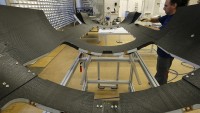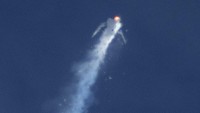NASA to Test on Dec. 4 Orion Spacecraft Capable of Bringing Humans to Multiple Destinations in Deep Space
| Vittorio Hernandez | | Nov 22, 2014 06:28 AM EST |
(Photo : Reuters) The Orion capsule is moved at Kennedy Space Center in Florida November 11, 2014. The NASA spacecraft designed to one day fly astronauts to Mars rolled out of its processing hangar at the U.S. space agency's Kennedy Space Center in Florida on Thursday to be prepared for a debut test flight in December. REUTERS/Mike Brown (UNITED STATES - Tags: SCIENCE TECHNOLOGY)
The National Aeronautic and Space Administration (NASA) is set to test next month the Orion spacecraft which would be capable of bringing humans to several destinations in deep space. The launch, though, would still be unmanned. It will be on December 4 at NASA's Florida Space Coast.
Like Us on Facebook
"It's a very important launch. And it really is historic to see a human-rated spacecraft to go farther than anyone has gone in 40 years. A real shot in the arm for NASA and the country," Click2houston quotes astronaut Rex Walheim.
Crewed missions would likely be in the early 2020s. Similar to the Apollo that brought astronauts to the Moon, the Orion Multi-Purpose Crew Vehicle could carry up to six spacemen for space travel to a captured asteroid or Mars. But it would surely be more advanced that Apollo with high-tech electronics, reports Space.com.
It would be partnered with the Space Launch System of NASA. It's a next-gen booster to bring astronauts out of low-Earth orbit again. But for its test flight, Orion would fly in tandem with a United Launch Alliance Delta 4 Heavy rocket.
For the test flight, Orion would fly 3,600 miles above Earth for 4.5 hours. Its mission is to try the systems needed for future human mission into deep space. The spacecraft will orbit twice and re-enter Earth at 20,000 miles per hour speed. When its temperature reaches almost 4,000 degrees Fahrenheit, Orion's parachute system will deploy to slow it down in preparation for a splashdown in the Pacific Ocean, reports Huffington Post.
In developing Orion, NASA aimed for a space vehicle that could fly for decades visiting various space destinations. Its design allows two round trips to Mars yearly. NASA also made it unnecessary to redesign the spacecraft or begin a new program even if new space destinations would be identified later.
Mark Kirasich, deputy program manager of Orion, adds, "What we're doing is about human exploration. It's about sending people to places that we've never been before. It's about expanding our knowledge base."
Tagsorion, spacecraft, NASA, Mars
©2015 Chinatopix All rights reserved. Do not reproduce without permission
EDITOR'S PICKS
-

Did the Trump administration just announce plans for a trade war with ‘hostile’ China and Russia?
-

US Senate passes Taiwan travel bill slammed by China
-

As Yan Sihong’s family grieves, here are other Chinese students who went missing abroad. Some have never been found
-

Beijing blasts Western critics who ‘smear China’ with the term sharp power
-

China Envoy Seeks to Defuse Tensions With U.S. as a Trade War Brews
-

Singapore's Deputy PM Provides Bitcoin Vote of Confidence Amid China's Blanket Bans
-

China warns investors over risks in overseas virtual currency trading
-

Chinese government most trustworthy: survey
-

Kashima Antlers On Course For Back-To-Back Titles
MOST POPULAR
LATEST NEWS
Zhou Yongkang: China's Former Security Chief Sentenced to Life in Prison

China's former Chief of the Ministry of Public Security, Zhou Yongkang, has been given a life sentence after he was found guilty of abusing his office, bribery and deliberately ... Full Article
TRENDING STORY

China Pork Prices Expected to Stabilize As The Supplies Recover

Elephone P9000 Smartphone is now on Sale on Amazon India

There's a Big Chance Cliffhangers Won't Still Be Resolved When Grey's Anatomy Season 13 Returns

Supreme Court Ruled on Samsung vs Apple Dispute for Patent Infringement

Microsoft Surface Pro 5 Rumors and Release Date: What is the Latest?












